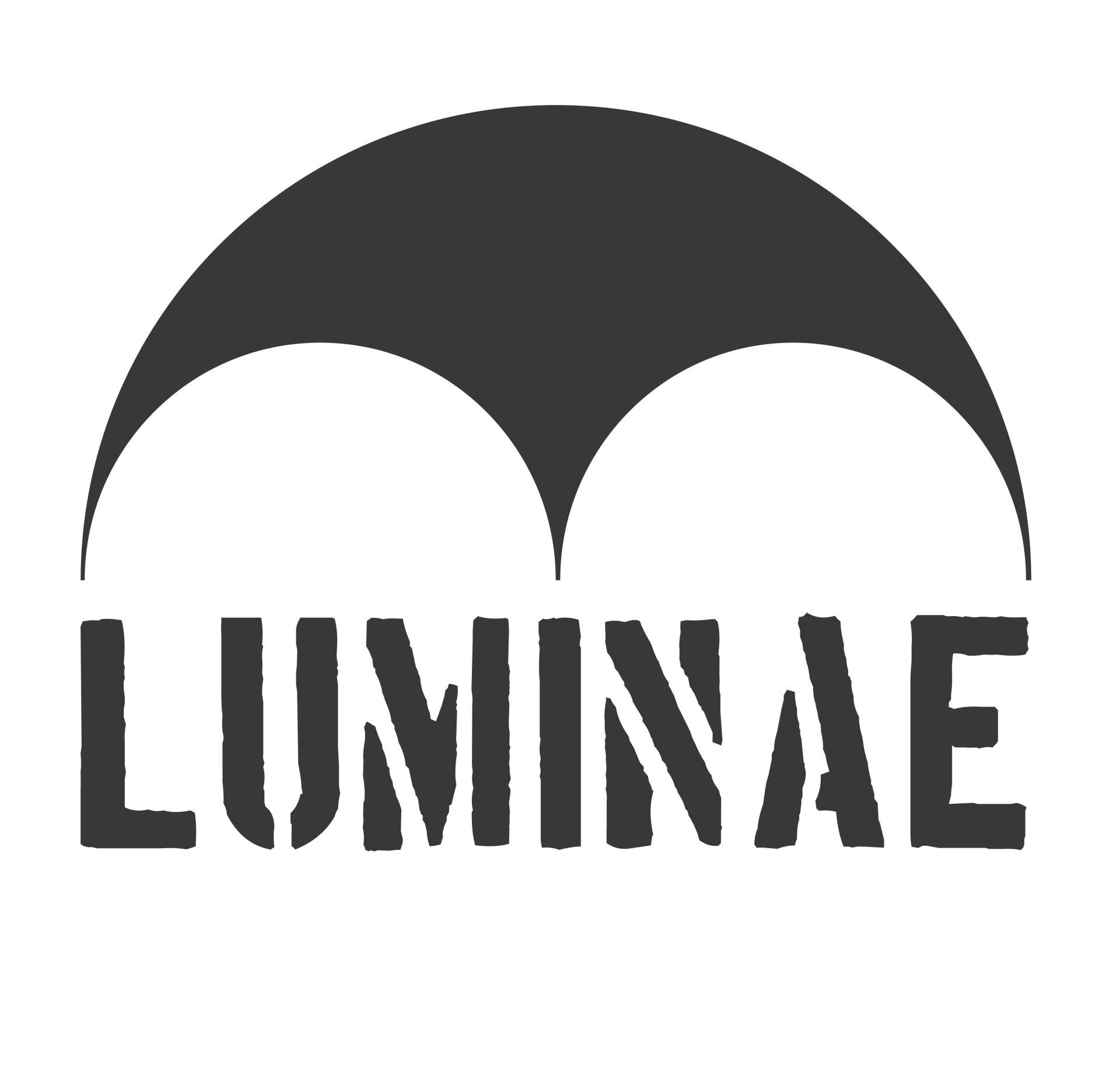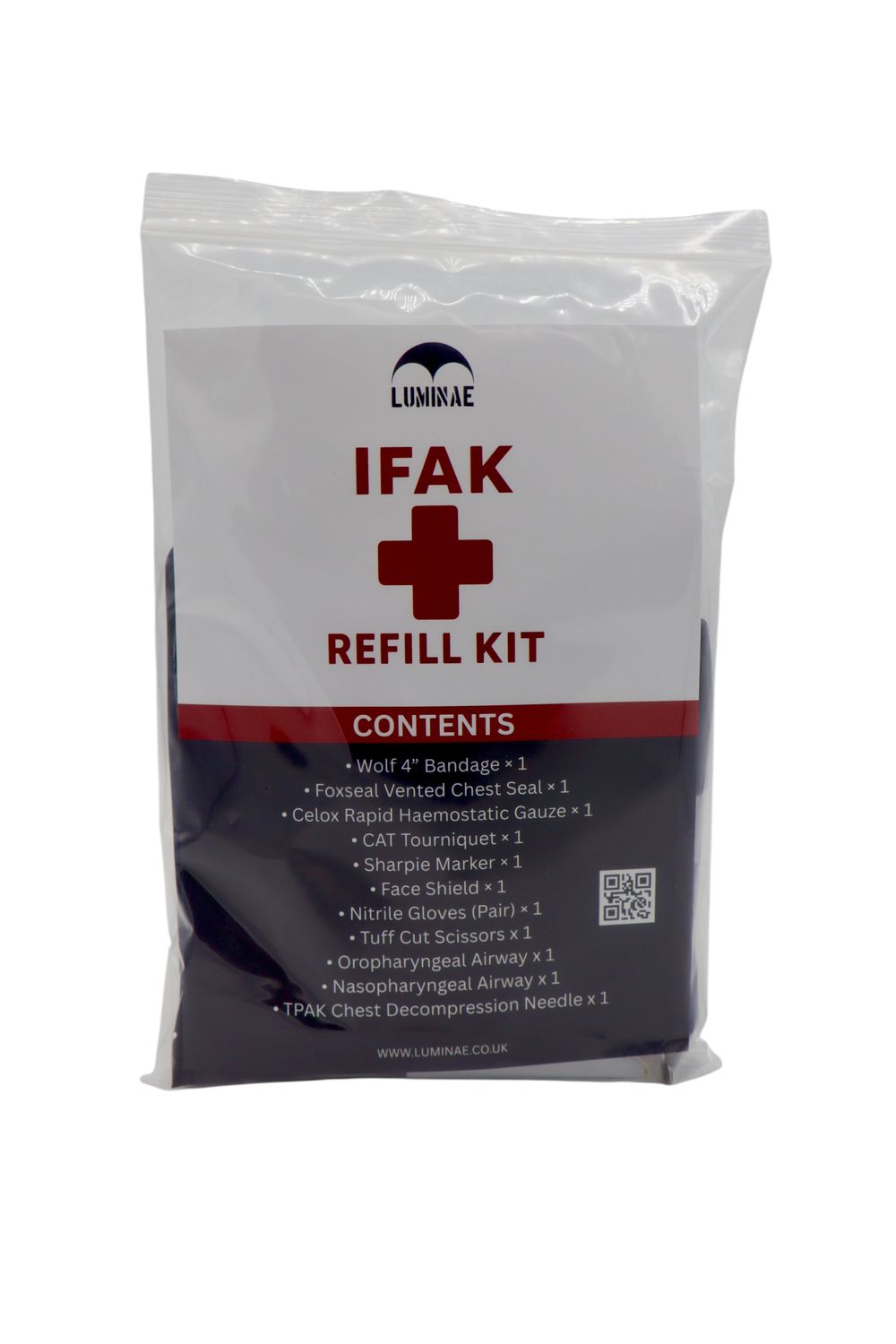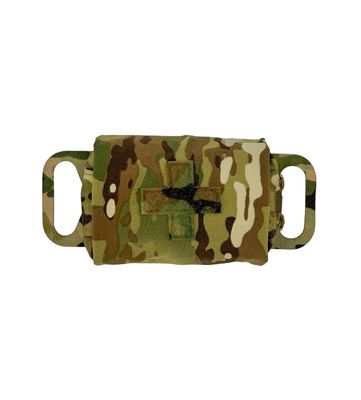Luminae IFAK Refill Kit
The Luminae IFAK Refill Kit is a complete, all-in-one medical contents package designed to restock or build your individual first aid kit or med pouch. It includes everything you SHOULD carry to treat life-threatening injuries in the field. Each component is sourced from trusted, industry-standard suppliers to ensure reliability, performance and quality when it matters most.
CONTENTS
Wolf 4″ Bandage × 1
This is a 4-inch wide trauma pressure dressing. It consists of an elastic wrap portion and an absorbent non-adherent pad. The elastic wrap allows the rescuer to apply sustained pressure over a bleeding wound, while the pad absorbs blood and protects the wound. The hook & loop “brakes” or stops prevent the wrap unravelling during application.
In use: apply the pad over the wound, wrap snugly with the elastic wrap to apply direct pressure, secure the wrap so it doesn’t loosen. This helps control external bleeding from injuries where a tourniquet isn’t appropriate (such as non-extremity wounds).
Foxseal Vented Chest Seal × 1
This is a dressing designed specifically for penetrating chest injuries (so-called “sucking chest wounds”). It attaches over a chest wall wound to prevent air being sucked into the pleural cavity (which can cause or worsen a pneumothorax). The “vented” version features multiple venting pathways (for example one version lists 512 vents) to allow trapped air inside the chest cavity to escape, reducing risk of tension pneumothorax.
In use: apply the seal directly over the chest wound (ideally when the casualty exhales so internal pressure is lower). Firmly adhere around the wound. If respiratory distress (tension pneumothorax) develops despite the seal, “burp” (lift a corner briefly) or remove and re-apply.
Celox Rapid Haemostatic Gauze × 1
This is a specialised haemostatic gauze that incorporates chitosan-based granules. Rather than relying solely on the body’s clotting mechanisms, the granules absorb blood fluid, swell, and form a gel-like plug at the source of bleeding. This allows the gauze to stop severe bleeding (including arterial) even in compromised conditions (e.g., hypothermia or anti-coagulated blood).
In use: expose the bleeding wound, pack the Celox gauze tightly into the wound cavity if needed, apply firm pressure (in training the manufacturer indicates ~60 seconds compression or until bleeding stops). Once stable, secure with a dressing or wrap.
CAT Tourniquet × 1
‘CAT’ stands for Combat Application Tourniquet (often the Gen 6 or Gen 7 model). This is a limb tourniquet designed to quickly and reliably occlude blood flow in an extremity (arm or leg) that is bleeding severely. It uses a windlass system, buckle, and strap to apply circumferential pressure until distal pulses are eliminated. The device is widely used, endorsed for tactical casualty care, and proven effective.
In use: place the tourniquet around a hands width above the wound (not over a joint), tighten the strap, twist the windlass until bleeding stops and pulse distal to the device is absent, secure the windlass clip, note the time of application (often written on the strap). Tourniquets are for extremity haemorrhage not controllable by pressure alone.
Sharpie Marker × 1
This is a permanent marker used to mark critical information on a casualty after application of certain treatments. For example, after applying a tourniquet the time of application is noted on the device or the casualty’s skin or clothing. It ensures that subsequent medical providers know how long the tourniquet has been in place, which is vital for safe management.
Face Shield × 1
This is a barrier device (typically transparent plastic) used when performing rescue breaths or mouth-to-mouth ventilation via a mask. It helps protect the rescuer from potential exposure to bodily fluids while still allowing the rescuer to deliver ventilations or act safely in an airway rescue scenario. In trauma IFAKs it is included to maintain hygiene and safety when airway support might be needed.
Nitrile Gloves (Pair) × 1
These are disposable gloves made of nitrile (latex-free) that the responder wears prior to touching the casualty or treating wounds. Their purpose is to protect both the casualty and responder from cross-contamination and bodily fluids, maintaining basic hygiene and safety in an emergency.
Tuff Cut Scissors × 1
These are robust trauma-shears (often with serrated blades) designed to cut through clothing, webbing, uniforms, boots or straps rapidly. In a medical kit they allow the responder to expose a wound quickly, cut off obstructive garments, and enable access to injuries (for example to apply haemostatic gauze or dress a wound). They are often stronger and more rugged than standard scissors.
Oropharyngeal Airway × 1
Also known as an OPA, this is an airway adjunct used to keep the tongue from occluding the airway in an unconscious patient who does not
have a gag reflex. The rigid curved device is inserted into the mouth, following the curve of the tongue, and helps maintain a patent airway (tongue out of the way). It allows ventilation (either assisted or spontaneous) by keeping airway open.
Important note: only use in patients without a gag reflex (i.e., unconscious) and only after airway obstruction due to tongue is identified. Improper use can cause vomiting and aspiration.
Nasopharyngeal Airway × 1
Also known as an NPA, this is a soft, flexible tube inserted through a nostril (after appropriate sizing and lubrication) into the nasopharynx and oropharynx to help maintain an airway. Unlike an OPA it can be used even if the patient has some gag reflex (though caution is required). It is particularly useful when the mouth is inaccessible, or if the responder needs to maintain airway patency but the patient is semi-conscious or has jaw/clenching issues.
In trauma settings it helps maintain or facilitate ventilation and oxygenation until more advanced airway support is available.
TPK Chest Decompression Needle × 1
This is a large bore needle/catheter device designed for needle thoracostomy (also called needle decompression) in the setting of a tension pneumothorax (air trapped under pressure in the pleural space, collapsing the lung and shifting mediastinum). For example the TPAK chest decompression needle is 10- or 14-gauge × 3.25-inch length to ensure adequate penetration of chest wall.
In use: when a casualty with chest trauma shows signs of tension pneumothorax (severe difficulty breathing, tracheal deviation, absent breath sounds on one side, hypotension) and trained personnel are available, the needle is inserted into the pleural space (for example 2nd intercostal space, mid-clavicular line) to relieve pressure. After insertion the catheter remains in place to allow continuous decompression of trapped air. This is a high-skill intervention for trained medics and not something to use without training.


